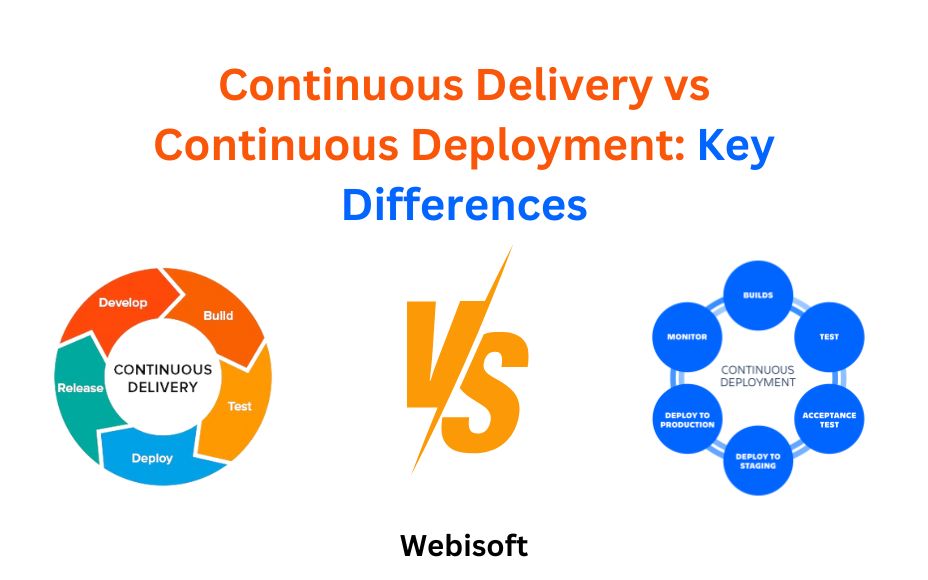In today’s fast-paced digital landscape, organizations strive to deliver software updates quickly and consistently. This is where Continuous Deployment emerges as a game-changer.
Deploying code changes to production is easier thanks to Continuous Deployment, which automates the process. But what is continuous delivery vs continuous deployment? How does it integrate with Continuous Integration?
In this article, we’ll explore the ins and outs of Continuous Deployment, its benefits, and how it complements other software development practices. We’ll show you a powerful approach for unlocking efficiency, enhancing collaboration, and getting things done faster.
Contents
How can Continuous Integration be Explained with an Example?
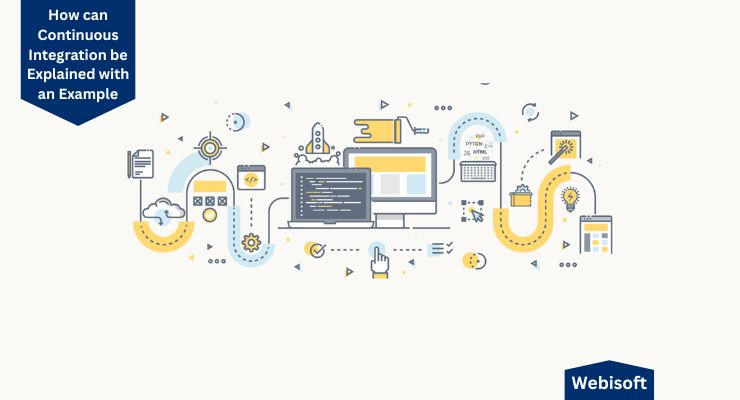
Think of it this way. The world of software development revolves around developers constantly contributing their unique pieces to a complex puzzle. This big picture puzzle is known as the central code repository, a meeting point for their collective work.
Frequent contributions – ideally, every day – are the norm in a game-changing process we’ve come to call Continuous Integration.
The Mechanics of Continuous Integration
It’s not enough to simply throw in chunks of code and expect magic to happen. Quality control is key. Here’s where an automated system shines, compiling the code and performing a plethora of checks.
Automated testing plays a critical role too, ensuring teams can promptly zero in on any discrepancies that might arise.
The Tale of Alex and Smith: Life Before DevOps
Before we dive deeper into Continuous Integration, let’s backtrack a little to the time before the rise of DevOps. Picture this – a bustling team of 30 to 50 developers, each tinkering away on their own features. We’ll focus on two of our fictional developers: Alex and Smith.
The two have a common goal: to align their respective work with the main codebase. Eventually, after several weeks or months, they would aim to blend their efforts.
But here’s the catch – even a minor alteration in a line of code by Alex, which Smith happens to delete, could lead to conflicts.
This scenario, while seeming innocuous, can be the root of new bugs. And this is just the tip of the iceberg. Imagine the chaos when more than ten developers concurrently work on an application packed with thousands, or perhaps millions, of files and features.
Continuous Integration: The Game-Changer in Software Development
Now, let’s flip the coin and examine the realm of Continuous Integration.
Alex, our hardworking developer, regularly contributes his working, albeit incomplete, code to the central repository. Simultaneously, Smith pulls Alex’s code and modifies it as required before diving into his own tasks.
The beauty of this system lies in its harmony. Alex and Smith work side by side on the same features, yet conflicts are kept to a bare minimum.
If any disagreements do pop up, they are generally restricted to the areas they were both involved in previously. This allows for easy communication and swift resolution.
The Role of Automation in Continuous Integration
Naturally, when a myriad of developers are constantly contributing to the repository, the chances of errors creep up. Here, automation comes to the rescue, diligently keeping tabs on the code around the clock.
Every time a change is made, automated builds and tests leap into action, ensuring no bugs sneak through undetected.
The Winning Benefits of Continuous Integration
The most prominent advantage of Continuous Integration is its uncanny ability to swiftly detect and pinpoint errors.
No wonder it’s become a best practice that developers swear by! It represents a powerful coding philosophy and a suite of practices that enable teams to roll out small changes and consistently commit code to version repositories.
What we’re looking at here is an automated way of developing, packaging, and testing applications – that’s the fundamental aim of Continuous Integration. By maintaining a steady integration process, teams can cooperate more efficiently and enhance the overall quality of software.
To successfully deploy ongoing integration, programmers should adhere to the following principles:
- Break it down into bite-sized parts during the initial stages of planning. Ideally, this strategy allows code to be merged into the mainline every day.
- Ensure every new feature, bug resolution, or enhancement undergoes automated testing. Making sure changes don’t affect other components is critical.
A smooth continuous integration process guarantees the mainline codebase is always ready for deployment. With automated tests, test-driven development, pair programming, streamlined designs, and refactoring, continuous integration elevates software quality.
It’s vital for the development team to adopt these practices wholeheartedly. Overlooking these techniques can undermine the efficacy of an automated implementation workflow. Secure automated deployment becomes a risky proposition without assurances that contributed code will work as intended.
What is Meant by Continuous Delivery?
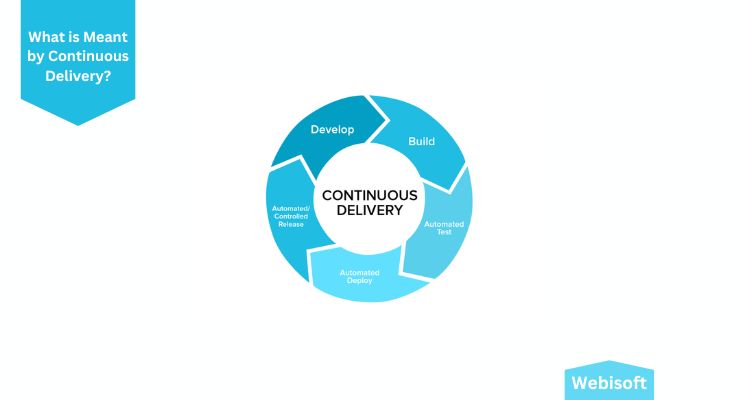
Picture this: Continuous Delivery is like a magic conveyor belt. It carries changes of every sort—
- be it tweaks in configuration,
- bug resolutions,
- novel features, or
- experiments—from the developers’ sandbox right into the production environment or into the eager hands of users.
With this sustainable cycle, the mainline is always prepared to go into production at the drop of a hat or the click of a mouse.
The Automation Magic
Click the button, and the magic starts. An automated pipeline swings into action, a crucial cog in the wheel of continuous delivery. But when should you dispatch your work into the production environment?
As it turns out, the sooner, the better. As per your business demands, quick deployment makes troubleshooting simpler by dealing with smaller, manageable chunks.
The Symphony of Automation and Manual Checks
Continuous Delivery aims to mechanize the entire software release process. After Continuous Integration, a release is prepared and queued up automatically to slide into production. However, continuous delivery isn’t a completely hands-off process.
It usually involves a manual step or two for initiating and approving a deployment to production. For complex systems with multiple dependencies, the continuous delivery pipeline might necessitate additional steps, either automatic or manual.
The Developers’ Checklist for Success
David Farley and Jez Humble, in their book “Continuous Delivery: Reliable Software Releases Through Build, Test, and Deployment Automation”, outline a handy checklist for developers before they submit their code:
- Confirm the build status. Is it currently in the “all clear” state? If not, lend a hand to fix the build before you contribute new code.
- If the build status is green, restructure your workspace in accordance with this setup.
- Make sure to build and test locally to avoid disrupting any functionality with your update.
- If your local build runs smoothly, you’re good to check-in your new code.
- Allow the Continuous Integration process to finish with the new changes.
- If the build hits a roadblock, pause, fix it on your machine, and revisit step 3.
- If a build failure occurs, shift your focus to another task in the pipeline.
Continuous Integration and Continuous Delivery are two sides of the same coin, with Continuous Testing being the edge that binds them. The end goal is always to deliver the best code and software to the users. Therefore, testing at every step of the way is essential for success.
The Role of Continuous Testing in Continuous Integration and Continuous Delivery
Both continuous integration and continuous delivery heavily rely on continuous testing. The objective is to consistently deliver excellent code and tools to users.
Continuous testing ensures that the software undergoes rigorous evaluation throughout the development process, contributing to the overall reliability and performance of the final product.
What is Continuous Deployment?
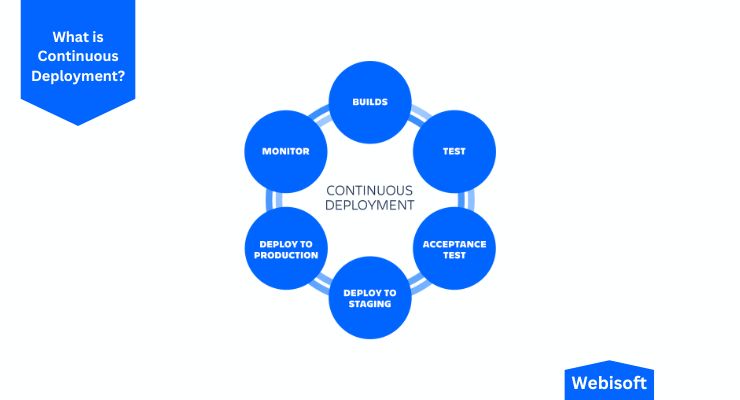
Continuous Deployment builds upon the concept of Continuous Delivery by automating the deployment process without needing formal consent from developers for every code change.
In Continuous Deployment, a developer’s responsibility usually concludes with reviewing and merging pull requests from teammates into the main branch.
From there, Continuous Integration/Continuous Delivery takes over, executing scripted tests and pushing the code to stage while providing updates to the team on each event’s outcome.
What are the Advantages of Continuous Delivery and Continuous Deployment?
When it comes to DevOps practices, both continuous delivery and continuous deployment have their roles to play. It’s not a matter of one being superior to the other; rather, it’s about choosing the approach that best suits your infrastructure.
At Webisoft, we take pride in our expertise in providing comprehensive DevOps support and services. With a track record of delivering quality results, our experienced professionals are committed to assisting clients in achieving their desired outcomes.
Both methods offer significant benefits for software development and operations, enabling smoother releases, more frequent iterations, and safer deployments.
Streamlined Releases at the Push of a Button
By automating testing and deployment through continuous delivery and deployment, the process of releasing software becomes effortless. Instead of spending days planning and executing releases, teams can now initiate them with a simple push of a button.
With continuous delivery, all changes are automated, ensuring the application can be automatically deployed to production as soon as it’s ready.
Accelerated Release Cycles for Enhanced Quality
Continuous delivery and deployment drastically reduce the time between releases, enabling faster feedback loops with customers. This, in turn, facilitates the rapid improvement of software quality with each iteration.
When releases can occur daily, as opposed to monthly or less frequently, customers can consistently experience the latest and highest-quality version of the software.
Reliable Releases with Built-in Safety Measures
Continuous delivery incorporates a manual approval stage prior to releasing to production, ensuring an additional layer of reliability.
When the right testing tools, strategies, and organizational culture are utilized, even continuous deployment can deliver more dependable releases.
By working with smaller change batches, these automated processes make it easier to identify and address any issues that arise, as opposed to infrequent, large-scale manual releases.
Reduced Manual Effort, More Focus on Quality
Continuous delivery and deployment empower development teams by providing near-instant visibility into changes. With minimal time spent on deployment and testing, more emphasis can be placed on enhancing the overall quality of the releases.
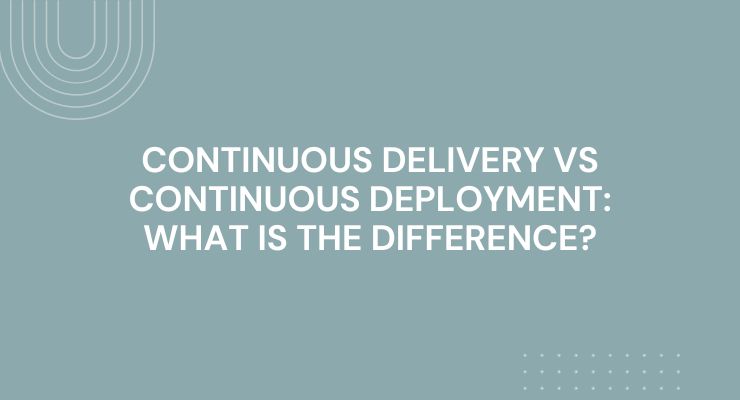
Continuous Delivery vs Continuous Deployment: What is the Difference?
Continuous Deployment is closely linked to Continuous Integration and emphasizes maintaining an application in a deployable state always. You can even release it to production as soon as the current version satisfies automatic tests.
To achieve rapid product releases, it is crucial to automate the whole process, not just testing. not just the testing phase.
On the other hand, continuous delivery requires manual involvement after acceptance testing to push the result into the production phase. After the automated tests are run, developers test the build with acceptance testing. Finally, they proceed to pass the automated tests in a testing or production setup.
Final Words
After exploring continuous delivery vs continuous deployment, it becomes evident that this automated approach can revolutionize software development. In addition to reducing bottlenecks, Continuous Deployment minimizes human error and accelerates deployment.
With Continuous Integration and Continuous Delivery, it creates a seamless ecosystem that keeps applications deployable and high-quality. As organizations increasingly seek faster and more reliable software releases, embracing Continuous Deployment becomes paramount. Using its power, businesses can drive innovation, boost customer satisfaction, and stay ahead in a dynamic industry.Our skilled DevOps engineers at Webisoft possess comprehensive knowledge of these processes and understand how to implement the appropriate system based on specific project requirements. Our DevOps experts can help you understand continuous integration, continuous deployment, and continuous delivery.
